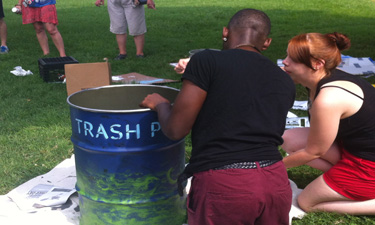 The notion of “civic hacking” is a relatively new concept, but it’s becoming a buzzword in municipal circles nationwide. The term refers to the growing trend of city planners who turn to local citizens for help in responding to local issues, in hopes that a broader group of creative minds might propose a wider range of innovative solutions. Cities like Philadelphia, Chicago and San Francisco have used civic hackers to improve communications between citizens and city hall, develop an app to reconnect towed cars with their owners, and make city legislation simple and conveniently accessible for citizens to navigate. Even the White House has jumped on the bandwagon, promoting the National Day of Civic Hacking in June 2013.
The notion of “civic hacking” is a relatively new concept, but it’s becoming a buzzword in municipal circles nationwide. The term refers to the growing trend of city planners who turn to local citizens for help in responding to local issues, in hopes that a broader group of creative minds might propose a wider range of innovative solutions. Cities like Philadelphia, Chicago and San Francisco have used civic hackers to improve communications between citizens and city hall, develop an app to reconnect towed cars with their owners, and make city legislation simple and conveniently accessible for citizens to navigate. Even the White House has jumped on the bandwagon, promoting the National Day of Civic Hacking in June 2013.
In Baltimore, the city’s Department of Recreation and Parks paired up with gb.tc, an organization of local innovation, tech and entrepreneurial experts, to encourage citizens to come up with ways to improve their public spaces. gb.tc, which derives its name from its forerunner, the Greater Baltimore Technology Council, works closely with the Mayor’s Office of Information Technology (MOIT), which provided $10,000 in funding to support the project. The three groups collaborated to launch the competition last spring.
“[MOIT CIO] Chris Tonjes was very interested in engaging with not just the technology, but the entire Baltimore community, and ‘hacking’ Baltimore’s public space seemed like a great way to bring people together while improving our city,” says Daniel Atzmon, policy analyst for the Baltimore MOIT.
About 20 project proposals came in during the entry period, and representatives from the three groups chose six pilot projects to fund and support over the summer.
The first project, dubbed Mycosolve, planned to enhance park soil, reduce erosion and prevent pollution from runoff by seeding native mushroom species in compromised areas. The second project aimed to improve logistics for the park system’s maintenance crews via a Mobile Maintenance Request System smartphone app. “Leakin Park Invasive Vine Control” was the third project selected, and it included plans to reduce the overgrowth of vines in this iconic park through volunteer mobilization and an app designed to gather crowdsourced vine mapping. The fourth project, “Hack the Trash,” intended to address complaints of missing trash cans in Patterson Park by turning donated oil drums into a public art installation. The fifth project sought to create a web-based, wiki-style map database of the trees in the city’s parks and ultimately the greater Baltimore region. Finally, the sixth project proposed a virtual tour guide to the city’s parks.
Projects were funded at the beginning of the summer, and the creative teams for each got to work, fine-tuning logistics and putting their plans into action. By late September, the first five groups had made significant progress toward their goals and presented their success to the competition’s organizers, including Baltimore Mayor Stephanie Rawlings-Blake (the sixth project wasn’t completed). Each of these showed measurable results and areas for future growth, and the parks department was extremely pleased with the results and subsequent improvements for their public spaces. The success of this competition also encouraged organizers to repeat the civic hacking model for future innovative solutions to city issues.
“In Baltimore, people really love their city and want to make it better,” says Sharon Paley, chief operating officer of gb.tc. “If you give them opportunities to do that, you’ll be surprised.”
As of February, Atzmon says, “All demoed projects are still going strong!”
Danielle Taylor is the Senior Editor of Parks & Recreation Magazine.

